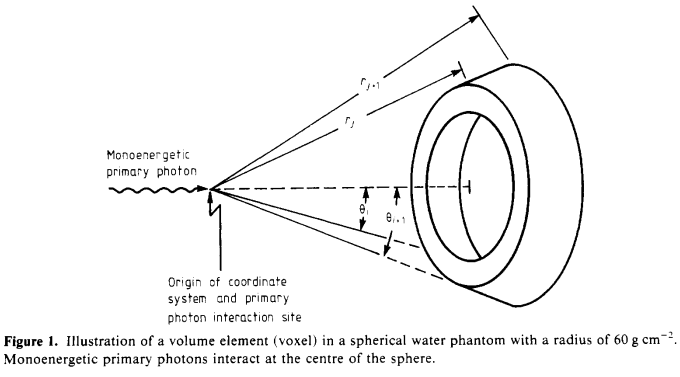Hi
I am using geant4 10.06.p02.
i want to divide a sphere into several shells with different radius.
i have used replica and G4VNestedParameterisation like i had used for Box before and it worked good.
this is my DetectorConstruction’s construct method :
G4NistManager* nist = G4NistManager::Instance();
G4Material* _world_mat = nist->FindOrBuildMaterial(“G4_Galactic”);
G4Material* _phantom_mat = nist->FindOrBuildMaterial(“G4_WATER”);
auto world_solid = new G4Box(“WORLD”,1m,1m,1*m);
auto world_logic = new G4LogicalVolume(world_solid,_world_mat,“World_logic”);
auto world_phy = new G4PVPlacement(0,G4ThreeVector(),world_logic,“World_PHYSI”,0,false,0,true);
auto sphere_solid = new G4Sphere(“sphere solid”,0,60cm,0deg,360deg,0deg,180*deg);
auto sphere_logic= new G4LogicalVolume(sphere_solid,_phantom_mat,“sphere logic”);
new G4PVPlacement(0,G4ThreeVector(0,0,0),sphere_logic,“sphere solid”,world_logic,false,0,true);
auto repSolidPhi = new G4Sphere(“_SOLID”,0,60cm,0deg,36deg,0deg,180*deg);
auto repLogicPhi= new G4LogicalVolume(repSolidPhi,_phantom_mat,“_LOGIC”);
new G4PVReplica(“repZ”,repLogicPhi,sphere_logic,kPhi,10,36*deg);
auto repSolidR = new G4Sphere(“_SOLID”,0,6cm,0deg,36deg,0deg,180*deg);
auto repLogicR= new G4LogicalVolume(repSolidR,_phantom_mat,“_LOGIC”);
std::vector<G4Material*> mat(2,_phantom_mat);
G4double dr=6*cm;
G4double dphi=36*deg;
G4double dtheta=180*deg;
Parameterisation* voxelpara = new Parameterisation(G4ThreeVector(dr,dphi,dtheta),(G4int)10,mat);
new G4PVParameterised(“voxel1”,repLogicR,repLogicPhi,kUndefined,(G4int)10,voxelpara);
and this is parameterization class :
Parameterisation::Parameterisation(const G4ThreeVector& voxelsize_sphere,G4int NZ_SPHERE,std::vector<G4Material*>& Mat):
G4VNestedParameterisation(),dr(voxelsize_sphere.x()),dphi(voxelsize_sphere.y()),dtheta(voxelsize_sphere.z()),nz_sphere(NZ_SPHERE),mat(Mat)
{
pz_cart.clear();
pz_sphere.clear();G4double z_sphere;
for(G4int i=0;i<nz_sphere;i++)
{
z_sphere=i*dr;
pz_sphere.push_back(z_sphere);}
}
Parameterisation::~Parameterisation(){pz_sphere.clear();pz_cart.clear();}
void Parameterisation::ComputeTransformation(const G4int copyNo,G4VPhysicalVolume* pv) const
{
G4ThreeVector origin(0,0,0/pz_cart[copyNo]/);
pv->SetTranslation(origin);
pv->SetRotation(0);
}
void Parameterisation::ComputeDimensions (G4Sphere& sphere,const G4int copyNo, const G4VPhysicalVolume*) const
{
sphere.SetInnerRadius(pz_sphere[copyNo]);
sphere.SetOuterRadius(pz_sphere[copyNo]+dr);
sphere.SetStartPhiAngle(0deg);
sphere.SetDeltaPhiAngle(dphi);
sphere.SetStartThetaAngle(0deg);
sphere.SetDeltaThetaAngle(dtheta);
}
i get this warning and it takes too long.
What is the problem?
is there any another way to divide a sphere into several shell for scoring ?


